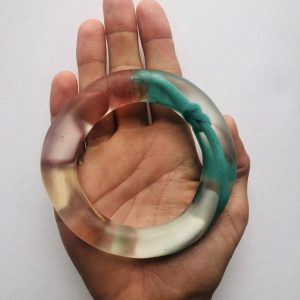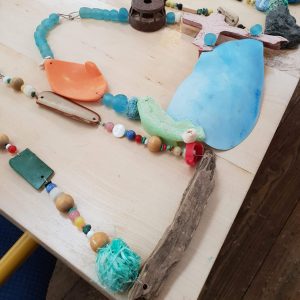Why Sustainability Is Important In Crafting
Do you Beach Clean? What do you do with your found treasures?
The Great British Beach Clean
This September, from the 17th to the 26th, thousands of people will take to the beach all over the UK to take part in the annual Great British Beach Clean. At Inspire Makers we champion sustainability wherever possible and have a number of makers who incorporate found items such as plastic waste into their work. It is a creative and innovative way of recycling, while also bringing attention to the issues surrounding plastic waste on our coastlines.
The Importance Of Using Sustainable Crafting Materials
While it was a strange and often difficult time, there were lots of positives that came out of the Covid-19 lockdown in the UK. A huge amount of people turned to creativity which provided an outlet, a distraction, and in some cases a potential new career. Home crafters were springing up everywhere, with Hobbycraft reporting a 200% boom in online sales for the first six months of the pandemic!
In addition to the growing popularity of crafting and creativity, when restrictions were at their strictest the human footprint on climate change was at its lowest for decades. It may not have been enough to make a lasting difference, but it showed that change is certainly possible. We are living through an environmental crisis and conscious consuming and creating is essential to limiting our ongoing impact on the planet.
If use of resources continues at the current rate, then research shows that we will deplete the earth’s natural resources in less than 100 years. We can use sustainable crafting practices such as recycling to help minimise our impact and even to make positive change, for example through collecting rubbish that would otherwise be harmful to the environment.
Many of the creative businesses at Inspire Makers are increasingly eco-conscious and we delve a little deeper into some of them below. Perhaps you will be inspired to make things out of your own found materials….
Washed and Found
Washed and Found jewellery was created by Viki Stiff when she felt compelled to make something beautiful out of the waste sea plastic that was being found on beaches in Cornwall and North Devon. Combining efforts with National Trust Rangers kickstarted the project and increased the amount of plastic collected.
Viki is inspired to make jewellery people can be proud of, not only visually but environmentally, to help keep the conversation alive and spark more ideas and action.
She uses plastic particles and fishing nets set in bio-resin to create simple, bold and wearable shapes. They are made individually and designed to hold a handful of sea plastic.
Porth Jewellery
Laura from Porth Jewellery makes unique pieces of jewellery with seaglass that she collects from beaches, harbours and estuaries around Cornwall and sometimes further afield. She likes to record where each piece is found and you can see it marked on the card that comes with each item.
Laura began her journey making jewellery in the Summer of 2018 after falling in love with the process and finding it an excellent use for her accumulated collection of seaglass.
She runs workshops at Inspire Makers where you are invited to choose your favourite seaglass and create a piece of jewellery around it. You can find a link to her workshops here.


Smartie Lids On The Beach
Living in Cornwall and so close to the beach, Michelle Costello has always cleaned beaches. She loves to look out for unusual items such as Smartie lids (which haven’t been in distribution since 2005!) and pieces of Lego from the Tokio Express container spill in 1997. She also collects micro plastic and nurdles which are less than 5mm, so 20/20 vision is essential!
The main reason for cleaning the beach for Michelle is the marine creatures. The beach is their home, and she believes that anything non-natural should be removed. As huge amounts of fishing waste wash up, she has also moved away from consuming fish.
Michelle says “I think people are becoming more aware of the problems of plastic in the environment and its overuse after seeing plastic washed up on beaches. This helps them make changes in their everyday lives, finding alternatives and refusing plastic. The more tourist popular beaches have definitely become cleaner over the past year as people use their initiative and pick up items, removing them from harm’s way.
“My art is the perfect way for me to get the message of marine debris across to people. It becomes a talking point, a story, a conversation starter. It allows the word to be spread.”

The Hide Studio
Working with the natural characteristics of the wood, Rich Inight of The Hide Studio, makes wooden bowls and other homewares from sustainably-sourced, local timber and driftwood from the beaches near their Morwenstow studio.
Their main ethos is creating usable objects with a clear emphasis on aesthetics and texture, whilst ensuring the smallest impact on the environment. They achieve this by using only wood from trees (almost always in their local area) which need to be felled or have already fallen, as well as driftwood from nearby beaches.
Sarah Drew
Sarah Drew is a found materials and eco-jewellery designer who turns beach finds into cool, contemporary statement jewellery using cold connection techniques such as threading, crochet, tiger tail and wirework.
Sarah loves collecting beach plastic, sea-glass, driftwood, ghostnet, twigs and rusty metal around her home in St Austell, Cornwall. She uses recycled materials and ‘rubbish’, combined with recycled silver and brass. Through this sustainable way of working, she creates unique pieces that aren’t a strain on resources.


Want To Hear More?
Sign up to the Inspire Makers newsletter for monthly updates on makers, classes and exhibitions.